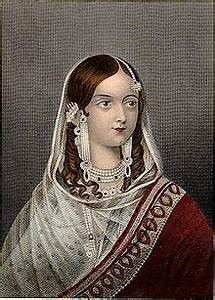
Begum Hazrat Mahal was a Muslim ruler of Awadh, India well- known forher bravery in taking control of ‘Awadh’ after he husband was exiled by the British empire. She rebelled against the british east india company during the Indian mutiny of 1857. Begum Hazrat Mahal (c. 1820 – 7 April 1879), also known as the Begum of Awadh, was the second wife of Nawab of Awadh , and the regent of Awadh in 1857–1858.
Early life
No concrete data is available about the childhood of Begam hasrat mahal.She was born in 1820 at Faizabad, the former capital of Oudh State.
She was known by the name Muhammadi khanum in the earlier part of her life and was brought up as a dancing girl by her parents, who then sold her to the royal Palace- harem of the ruler of Awadh.
Her life in the palace of Awadh began as a ‘khawasin’ (maid), and later promoted as ‘pari’ (fairy). Later she became the concubine of the nawab of Awadh Wajid Ali Shah. During that relationship with nawab she gave birth to a son, Birjis qadar, the tajdaar-e-Awadh. The nawab married her, to make the son his legitimate heir, and then named her Begam Hazrat Mahal, the name with which she is known to history of India.
The British East India company annexed Awadh in February of 1856, in its conquest of Indian states and annexation to British empire. As per the contract with East India company Nawab of Awadh agreed to be pensioned off to Calcutta and begam was not part of that entourage. Begam Hazrat Mahal was left in Awadh and she decided to fight for her rights in Awadh remaining with people of the land.she made her son, Prince Birjis Qadr, the ruler of Awadh, with herself as regent during his minority.
In 1857 the sepoy mutiny erupted due to the prolonged resentment and intolerance with the reign of East India company among Indian soldiers. Its repercussions echoed in Awadh too.
Begam Hazrat Mahal and her people made an army against the British East India company and decided to fight. She rebelled against the forces of the British under the leadership of Raja Jailal Singh; they seized control of Lucknow and she took power as the guardian of her minor son, Prince Birjis Qadr, whom she had declared as the ruler.
As regent, she automatically came to have a leadership role in the rebellion against the British.
Begam Hazrat Mahal took control of affairs as her son’s regent of Awadh and fought relentlessly for ten months against the British. She was praised by many people of her time, ranging from the ordinary citizen of Awadh to the Mughal emperor – Bahadur shah jafar for her courage and exemplary rule.
Hazrat Mahal worked in association with Nana saheb, but later joined the Maulavi of faizabad in the attack on Shahjahanpur.
A few British accounts of the battle of Musa bagh in Lucknow, testify that the begum was personally present in the battle ground, fighting and rallying the 9,000 rebels there. She was found in the war field riding an elephant during the battle as well.
But It was difficult to stand against the mighty British for long for a small state like Awadh. She had to withdraw herself in front of the fire power and strategic help of other regions to British. However, she was not ready to surrender to the British army and live in exile.
At the end of the war begam rejected the pension and mercy of British throne. She slipped out of Lucknow to the Himalayan belt fighting with the army and sought refuge in Nepal. She lived in Nepal till her last breath with no wealth left. Yet she was not ready to surrender to British throne even in those adverse circumstances. When she died in Nepal in 1879, it was very difficult to find money even for a grave for the people around her.
Begum Hazrat Mahal’s tomb is located in the central part of Kathmandu near Jama Masjid, Ghantaghar,
She will be remembered in the history of India for the exemplary courage with which she fought against British army and later preferring an ordinary life rejecting their agreement of pension by surrendering.
After her death, on the occasion of the jubilee of Queen of England (1887), the British Government pardoned her son Birjis Qadr and he was allowed to return to India.
Memorials & honours
On 15 August 1962, Begam Hazrat Mahal was honoured at the Old Victoria Park in Hazratganj, Lucknow for her role in the Great mutiny in 1857. The renaming of the park to Begam Hazrat mahal park in her honour took place in this year and also a marble memorial was constructed, which includes a marble tablet with four round brass plaques bearing the coat of arms of the Awadh royal family.
A scholarship is given in her name through Maulana azad foundation to meritorious Girls belonging to minority communities by the government of India.
Leave a Reply